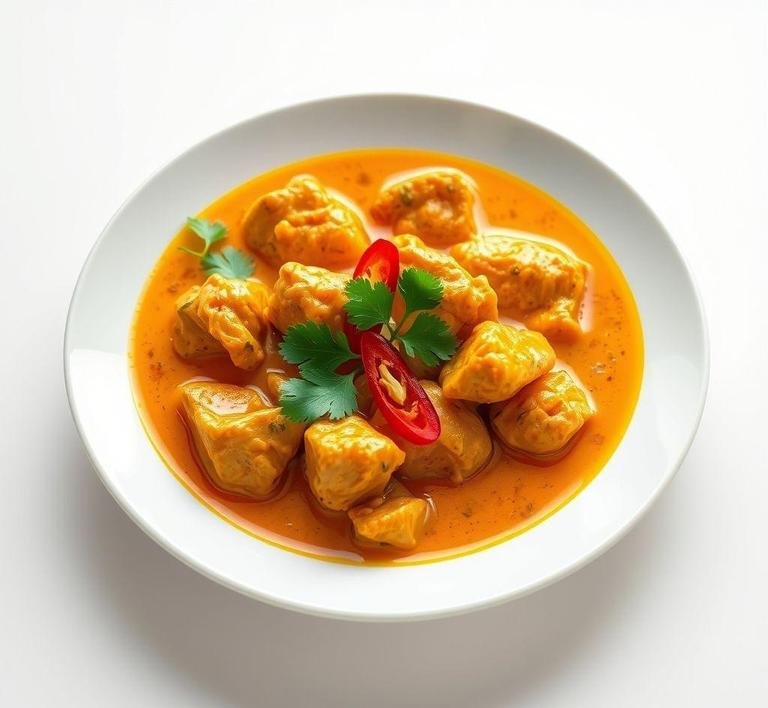Jamie Oliver’s Balinese Chicken Curry is a flavorful, aromatic dish inspired by the tropical island of Bali in Indonesia. Known for its punchy, spiced flavors and fresh ingredients, this curry blends the rich taste of chicken with a symphony of herbs and spices. The recipe combines traditional Balinese ingredients like coconut milk, lemongrass, turmeric and kaffir lime leaves to create a creamy, fragrant curry that’s both comforting and vibrant.
Jamie takes a bit of a shortcut with his version, making it easier for everyday cooks to recreate this complex dish at home without sacrificing its authentic flavor. It’s a great balance of heat, creaminess and freshness, perfect for those who love bold, exotic flavors but aren’t looking for something too complicated.
Jamie Oliver Balinese Chicken Curry Recipe
Ingredients Needed
To make this Balinese Chicken Curry, you’ll need a few key ingredients that bring out those amazing flavors. Here’s a breakdown of what you’ll need:
- Chicken – Bone-in, skinless chicken thighs are ideal. They’re juicy, tender and soak up the curry flavors beautifully.
- Coconut Milk – Adds a rich, creamy texture to the curry, mellowing out the heat and making it luscious.
- Lemongrass – This herb gives the curry a citrusy, fresh kick. You’ll need to bruise it to release its oils and flavors.
- Kaffir Lime Leaves – They provide a unique, fragrant lime flavor that’s a hallmark of Balinese cuisine.
- Turmeric – For that golden color and earthy warmth.
- Chilies – Fresh red chilies bring heat to the dish but you can adjust the amount depending on how spicy you want it.
- Garlic and Shallots – These form the aromatic base of the curry, adding depth and sweetness.
- Ginger – It adds a zesty bite and works well with the other aromatic ingredients.
- Coriander – Fresh coriander/cilantro to garnish and add a fresh, herbaceous note.
- Fish Sauce – A touch of fish sauce balances out the flavors with some saltiness and umami.
- Brown Sugar – A small amount to help balance the heat and acidity with a bit of sweetness.
Optional additions can include things like lime juice and you could throw in some vegetables like bell peppers or carrots if you want to add more texture and color.
Equipment Needed
You don’t need anything fancy to make this dish, just the basics:
- Large pot or Dutch oven. For cooking the curry and letting everything meld together.
- Mortar and Pestle (or food processor). You’ll need this to grind your aromatics (garlic, shallots, ginger, turmeric) into a paste. It’s a step that brings out the full, intense flavors of those ingredients.
- Knife and Chopping Board. For preparing the chicken and chopping the herbs and veggies.
- Wooden Spoon or Spatula. To stir the curry and ensure it doesn’t stick.
- Lid – A good lid helps the curry cook evenly and trap all those delicious smells while it simmers.
How To Make Jamie Oliver’s Balinese Chicken Curry
Making this curry is simpler than you might think, even though it’s packed with flavor. Here’s a step-by-step:
- Prepare the aromatics – Start by grinding your garlic, ginger, shallots and turmeric into a paste. Use a mortar and pestle or a food processor to get a smooth consistency. This paste will be the heart of your curry.
- Cook the paste – Heat some oil in your pot over medium heat and cook the paste for about 5-6 minutes. You want it to become fragrant and golden, releasing all the oils from the ingredients.
- Brown the chicken – Add the chicken pieces to the pot and brown them on all sides. This step helps seal in the juices and adds a deeper flavor to the dish. You don’t need to cook them all the way through; they’ll finish cooking later in the sauce.
- Add the liquids – Pour in the coconut milk, fish sauce and a little water to create the curry base. Stir everything together and bring it to a gentle simmer.
- Add herbs and spices. Add in the bruised lemongrass stalks, kaffir lime leaves and red chilies. These are the ingredients that will give your curry that amazing, fresh flavor.
- Simmer – Let everything simmer gently for about 30-40 minutes. The chicken should be cooked through and tender and the flavors will meld together into a rich, flavorful sauce.
- Finish with garnish – Once the curry is done, stir in some fresh coriander. You can also add a squeeze of lime juice if you want an extra zesty touch.
Serve this curry over steamed rice to soak up all the creamy, fragrant sauce. And that’s it! You’ve got a bowl of Balinese comfort food, bursting with fresh flavors.
What I Learnt

Making Jamie Oliver’s Balinese Chicken Curry was an eye-opener for me in terms of balancing flavors. The simplicity of the recipe belies how complex the flavors are when they all come together. The coconut milk makes the curry feel rich and luxurious while the kaffir lime leaves and lemongrass bring in that bright, almost zingy freshness. It was amazing how the combination of salty, spicy and sweet ingredients created such a well-rounded dish.
I also learned how powerful a simple paste of garlic, ginger and turmeric can be. It’s the backbone of the curry and I’d never realized how much depth it added until I tasted the dish. And the step of simmering the chicken in the curry base really made a difference-keeping the chicken juicy and infused with all those beautiful flavors.
Recipe Tweaks For Jamie Oliver’s Balinese Chicken Curry
Jamie Oliver’s Balinese Chicken Curry is already a flavor-packed, aromatic dish but sometimes you just want to tweak it a little bit to match your taste or available ingredients. Here are a few ways you can modify it:
- Spice Level Adjustments: The curry’s heat comes from fresh chilies and curry paste. If you want it spicier, add more bird’s eye chilies or a spoonful of chili paste. For a milder curry, reduce the chili count and opt for a bit of ginger or turmeric to keep the warmth without overpowering your palate.
- Substitute Proteins: While chicken is the star here, feel free to swap it out. Fish like cod or snapper works well or go for tofu if you want a vegetarian twist. These swaps will change the texture but still give you a comforting, rich curry.
- Coconut Milk Variations: The creaminess in this dish comes from coconut milk. You could experiment with light coconut milk for a less rich version or add a splash of coconut cream for an even thicker, creamier texture.
- Extra Veggies: Feel free to throw in some additional vegetables. Zucchini, bell peppers or carrots can enhance the curry’s color and flavor. They also provide a great contrast to the soft chicken and creamy sauce.
- Herbs and Garnishes: A little twist in the herbs can elevate the dish. Try some fresh basil, cilantro or even mint to add a bright, fresh layer to the rich, savory flavors. A squeeze of lime just before serving can also bring a zesty kick.
Storage Tips For Leftovers
If you find yourself with leftovers after making Jamie Oliver’s Balinese Chicken Curry (which is often the case given how hearty it is!), here’s how to store it:
- Cool It Quickly: Before putting the curry in the fridge, let it cool down to room temperature. This prevents it from heating up your fridge and compromising the quality of other food. You can spread it out on a shallow dish to cool faster.
- Airtight Containers: Store the curry in airtight containers to keep the flavors intact and prevent it from absorbing other smells from the fridge. It’s best to store the curry and rice separately if you have it as part of the dish.
- Refrigeration: Leftovers can be kept in the fridge for about 2-3 days. Be sure to consume it within that time for the best taste and safety. If you can’t finish it, freezing is a good option.
- Freezing Leftovers: If you want to store it for longer, freeze your curry for up to 3 months. When reheating, make sure it’s fully thawed and reheated to a boiling point. This will keep it safe to eat and prevent any changes in flavor or texture.
- Reheat Gently: When reheating the curry, go slow and low. Bring it to a simmer on the stove or use a microwave, stirring occasionally to ensure it heats evenly. Adding a splash of water or coconut milk can bring back some of the original creaminess.
What To Eat With Jamie Oliver’s Balinese Chicken Curry?
This Balinese Chicken Curry can easily stand on its own but if you’re looking to make it a full meal, here are some great sides to pair with it:
- Steamed Jasmine Rice: The subtle, fragrant flavor of jasmine rice is perfect for soaking up the rich, creamy curry sauce. It’s the classic pairing and balances out the spice and heat.
- Naan or Flatbreads: If you’re craving something other than rice, warm naan or any flatbread works wonders. You can use it to scoop up the curry, making each bite satisfying and a little indulgent.
- Simple Cucumber Salad: A crisp, fresh cucumber salad with a light vinaigrette can cut through the richness of the curry. Add a bit of chili for some heat and a sprinkle of sesame seeds for texture.
- Grilled Vegetables: Roasted or grilled veggies like sweet potatoes, eggplant or bell peppers provide a nice contrast to the creamy curry. The slight char from grilling adds a smoky note that complements the dish.
- Pickled Vegetables: For a bit of tang, some quick-pickled onions or carrots can add a burst of acidity that balances out the richness of the curry. They also provide a bit of crunch which contrasts nicely with the tender chicken.
- Roti: If you’re looking for something a little more indulgent, roti works as a great side. It’s buttery and soft, perfect for dipping into the curry sauce.
FAQs
What Ingredients Do I Need For Jamie Oliver’s Balinese Chicken Curry?
You’ll need chicken, coconut milk, curry paste, fresh ginger, garlic, lime, cilantro, and a few other tasty spices like turmeric and coriander.
How Long Does It Take To Make Jamie Oliver’s Balinese Chicken Curry?
It takes around 45 minutes to 1 hour, depending on how fast you prep the ingredients!
Can I Make Jamie Oliver’s Balinese Chicken Curry Ahead Of Time?
Yes! It actually tastes even better the next day, so feel free to prep it in advance and just reheat.


